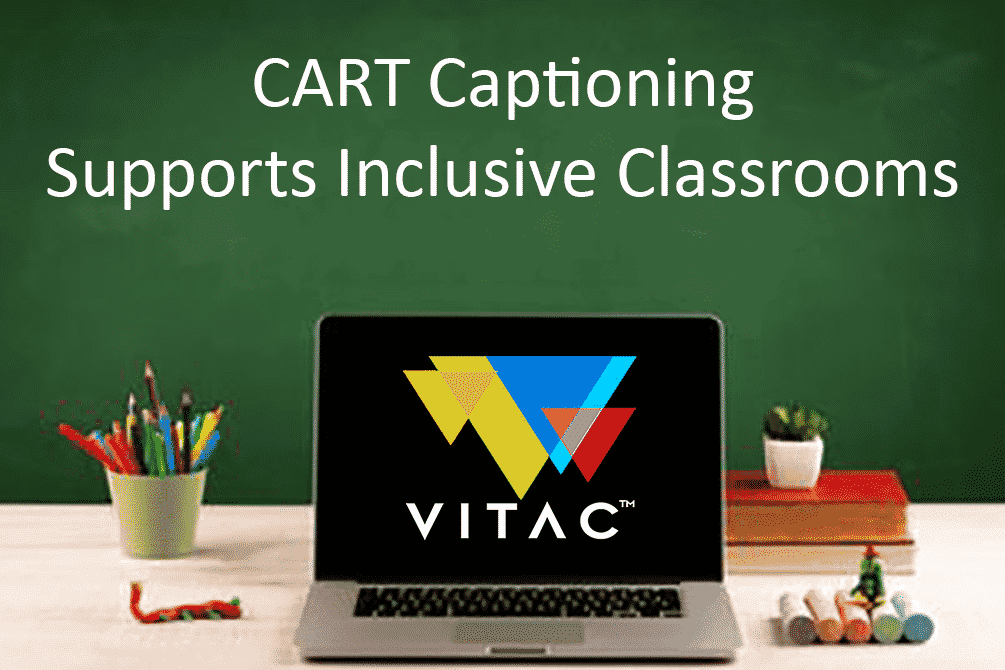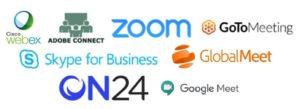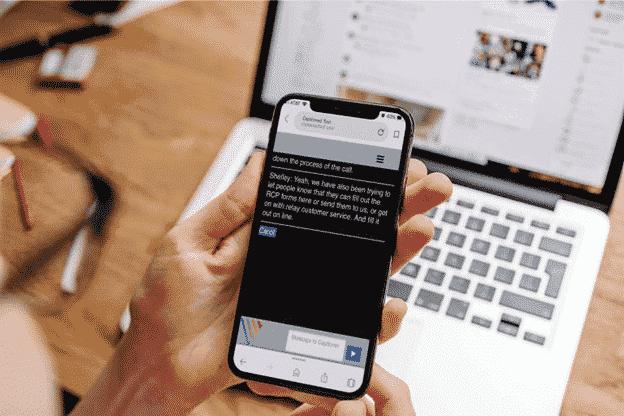CART Captioning Quote Request
Please note that due to increased demand, VITAC has instituted a minimum charge for all orders.
CART Captioning for Education, Live & In-Person
If you’re looking for a high-quality, accurate, and compliant CART captioning service to help support your school – whether it be for students, teachers, or other staff members – then you’ve come to the right place. Our CART captioning service is great for distance learners and in-person classes. We also offer a wide range of other accessibility services.
VITAC has been providing closed captioning and accessibility services for more than 30 years. A number of schools, nationally recognized universities, community colleges, online lecture providers, and informational program producers trust us as their reliable CART captioning and accessibility service provider.
Contact us today to learn more.
[contact-form-7 id=”17421″ title=”Adwords Education”]
How VITAC Supports Equal Access in Education
There is no doubt that captions in the classroom and other learning spaces are crucial for deaf and hard-of-hearing students, but they have been proven to benefit others as well. Studies have shown that adding captions to digital content can help both visual and auditory learners, and improve comprehension, engagement, retention, and the overall learning experience for all students and not just those requiring accessible content.
At VITAC, we believe that everyone should have the same access to content. We work with many colleges and universities, institutions and organizations, and programs and platforms to ensure that everyone has equal access to course materials, lessons, webinars, presentations, lectures, remote and in-person meetings, and more.
Our solutions include:
- CART Captioning services for remote and in-person classes, meetings, and conferences
- Realtime, Live Captioning for streaming and broadcast video on remote platforms like Zoom, ON24, Webex and more. Also a great solution for non-broadcast sporting events and graduation ceremonies
- English and Spanish Subtitles for educational and training programs funded by the federal government
- Audio Description services so that students who are blind or low-vision may participate in the same manner as their sighted peers
- Offline Captioning for online lecture platforms and prerecorded classroom video content for students of all ages. Great for video libraries
Benefits Gained When Providing Captions
Focus, Focus, Focus
Captions can help students focus, clarifying a video’s muffled or distorted audio, dialogue − particularly accented speech − and technical terms and jargon (remember that physics teacher who always mumbled about quarks, tachyon, and absorption spectroscopy?).
Transcripts as Study Guides
Captions also provide the added benefit of transcripts, a written summary of all that was said during a class or a webinar or a workshop. The host may share a transcript at the conclusion of the captioned event, enabling all participants to have a summary of what was discussed, including key thoughts, stats, and information that can be revisited later.
English Language Learners
Captions also are beneficial to English Language Learners (ELL), or students who are learning the English language in addition to their native language or any other languages they may speak. According to the National Education Association, by the year 2025, 1 out of 4 children in classrooms across the nation will be ELL students. The association notes this to be the fastest growing group of students in grades K-12.
As noted above, captions provide a written transcript of an event and give ELL students the opportunity to improve comprehension and word pronunciation, review confusing materials, or reference difficult or complex terms that they may have had trouble translating without a written reference.
On-the-Go Studies
Captions enable students to take their online video homework anywhere – whether it be the campus coffee shop or the local neighborhood hang-out. Adding captions to online course materials and videos posted on the school’s media pages mean that students can study almost anywhere, even the noisiest of locations.
It’s the Law
The Americans with Disabilities Act and Section 504 of the Rehabilitation Act require most educational videos to be captioned or otherwise accessible to ensure effective communication.
Section 504 states that no individuals with a disability should be excluded from or denied the benefits of any program, institution, or activity that receives Federal financial assistance, like many colleges and universities do. The ADA and Section 504 apply to a broad range of school programs, services, and activities, including lessons, board meetings, extracurricular programs, teacher conferences, recreational activities, social and cultural activities, adult education, and summer school.
Captions also help satisfy WCAG guidelines for accessible website content. The guidelines are based on four principles – that all content should be perceivable, operable, understandable, and robust for everyone – and cover everything from screen reader navigation to color contrast to captions and audio description.
CART Captioning Services, Remote & In-Person

Communication Access Realtime Translation (CART) captioning is the live display of verbatim speech-to-text and is offered either remotely on in-person.
Remote CART captioning involves a human captioner listening to the audio of the lesson, lecture, or event. The captioner listens via an IP audio connection (such as Zoom) and quickly sends the captions to a dedicated URL. The the student, or user, can access that URL and save for later study. It’s also used in meetings, seminars, conferences, and presentations.
Remote CART captioning has a few additional advantages — multiple users can use it and captions can be streamed directly to the college or university’s Learning Management System (LMS) so that an accessible version is available for future reference.
In-person CART features an on-site captioner who sits in the classroom next to the student and creates captions. The student and captioner share a screen, and captions appear as the instructor speaks them.
No matter the need, our professionals are here to help you every step of the way, and will work with you to make sure you’re not tardy when it comes to accessibility.
Accessibility Solutions for Educational Institutions
Offline Captioning: We worked with a leading provider of online math videos to create captioned, accessible content. The provider first attempted an automated captioning solution − with transcripts uploaded and automatically timed by an engine − but quickly realized that fractions and formulas weren’t well-suited for an automated atmosphere as captioned formulas routinely were split over multiple lines. We jumped in to help and created verbatim translations in English and Spanish, and manually formatted captions to ensure the subject matter was readable and understandable.
Realtime Captioning: An Ivy League college was looking to provide captioning for sporting events distributed via their online portal. We worked with the institution to install the proper equipment and began scheduling and captioning live events.
Distance Education Captioning and Transcription. VITAC is a pre-approved vendor for the California Community Colleges’ Distance Education Captioning and Transcription (DECT) grant. The grant enables California Community Colleges to expand their video accessibility efforts by providing funding for live and prerecorded captioning and transcription as a means of enhancing access for all students in distance education courses. We are one of only two approved vendors for live captioning, which includes captions for classes, lectures, and podcasts delivered live via webcast, broadcast, internet TV, and other means.
YouTube Solutions: A university posting lectures and lessons to its YouTube Channel was looking for a way to make its videos searchable and accessible to its deaf and hard-or-hearing students. As a “YouTube Ready” caption vendor, we designed a simple solution for delivery of video and receipt of caption files.
VITAC’s Reach Further Program™
Delivering educational programs and classroom experiences to those who have accessibility needs requires a lot of responsibility. Not to mention handling regulatory compliance such as the Americans with Disabilities Act (ADA), Section 508, and Section 504 Department of Education requirements. Creating inclusive education can be complicated, but we can help.
VITAC is the only closed captioning company in the world with a Reach Further Program™ dedicated to helping you connect with a larger learner base. This program includes:
- Experience and understanding what you need as we are the largest and most trusted captioning provider in the industry
- Proactive Education to create more inclusive opportunities for learners
- Reliability with the longest track record
- Compliance with ADA, Section 508, and Section 504 regulations
- Responsiveness to be there when needed, with a real person ready to help
- Uptime at 99.9% with the best infrastructure, technology, and redundancy
- Expertise from people who set the standards
- Accuracy on all your captioning needs with our exclusive H Factor (our human touch)
- Depth of Services with live, prerecorded, multi-language, audio description, transcription, and more

Virtual Classes & Events, Live Captioning Solutions
There’s a reason why we are considered the preferred live captioning vendor for the top ivy-league university in the U.S. We understand your world and what you need to make your classes and materials accessible. We connect your message to your audience, making your life easier!
Our remote meeting integrations make it easy to add captions to your online classes and instruction. Our live captions integrate with most streaming video platforms like Zoom, Webex, Adobe Connect, ON24, and more.
Contact us today to learn how we can help you create virtual events that everyone can enjoy!

View Captions Easily with Our Internet Captioning Service
Experience the convenience of compatibility with any online video or audio platform. Our Internet Captioning Service (ICS) is a convenient, web-based streamer that allows you to view captions on a computer, tablet, or mobile device.
With ICS, your students, staff, and meeting participants can stream live, realtime captions anywhere at anytime using the same highly-skilled human captioners that produce English and Spanish closed captioning for live television, news, and sports.

The Many Benefits of ICS
ICS makes it easy to access live, realtime captions with a simple internet connection, and it’s compatible with Zoom, Adobe Connect, GlobalMeet, Google Meet, GoToMeeting, Microsoft Teams, ON24, Twitch, Vimeo Livestream, Webex, and Wowza.
When you order ICS, you gain a variety of benefits, including:
- Captions are displayed in an on-screen player using an event-specific URL. No download or plugin(s) required, and no limits on audience size
- Captions appear in a responsive, mobile-friendly, browser window while viewing a video, presentation, or web conference in a separate window
- Reliable, Accurate, high-quality captioning services by professional captioners
- Convenient online scheduling platform. Select event management settings to request edited transcripts, disable transcripts for privacy, and more
- Custom caption preferences which include font, background, text display style, and timing
- Allows viewers to scroll through the current discussion in the ‘Live Captions’ window, toggle to the realtime transcript window, or save the transcript at any point during the session*
- Easily distribute or archive unedited transcripts in multiple file formats (.txt, .rtf, .doc, .docx, or .pdf)
- We provide a secure, encrypted https connection. ICS player requires JavaScript to be enabled
- You get dedicated customer service, user instructions, and technical support for all our customers
- Accessibility for all. Captioning benefits everyone, helping viewers absorb information in noisy or crowded environments, and substituting text for poor sound quality
Securing Your Data
At VITAC, we apply a high degree of importance to our management and protection of client information and data. We design our networks, workflows, and applications to meet high security standards, and continuously work to improve our systems and practices to provide the most secure environment.
Educational Data Security
Frequently Asked Questions
Q: How do you ensure accuracy in live captioning?
Q: Can captions be created in different languages?
Q: Do you caption classrooms?
Q: Does VITAC support realtime captioning for web streaming services such as Webex, Zoom, or ON24?
Q: How are live, or realtime, captions created?
Q: How do I ensure my information is secure?
Q: How do you decide what is important to caption?
Q: How do you ensure accuracy in prerecorded captioning?
Q: Who do I call with an emergency?
Q: What standards do you follow?